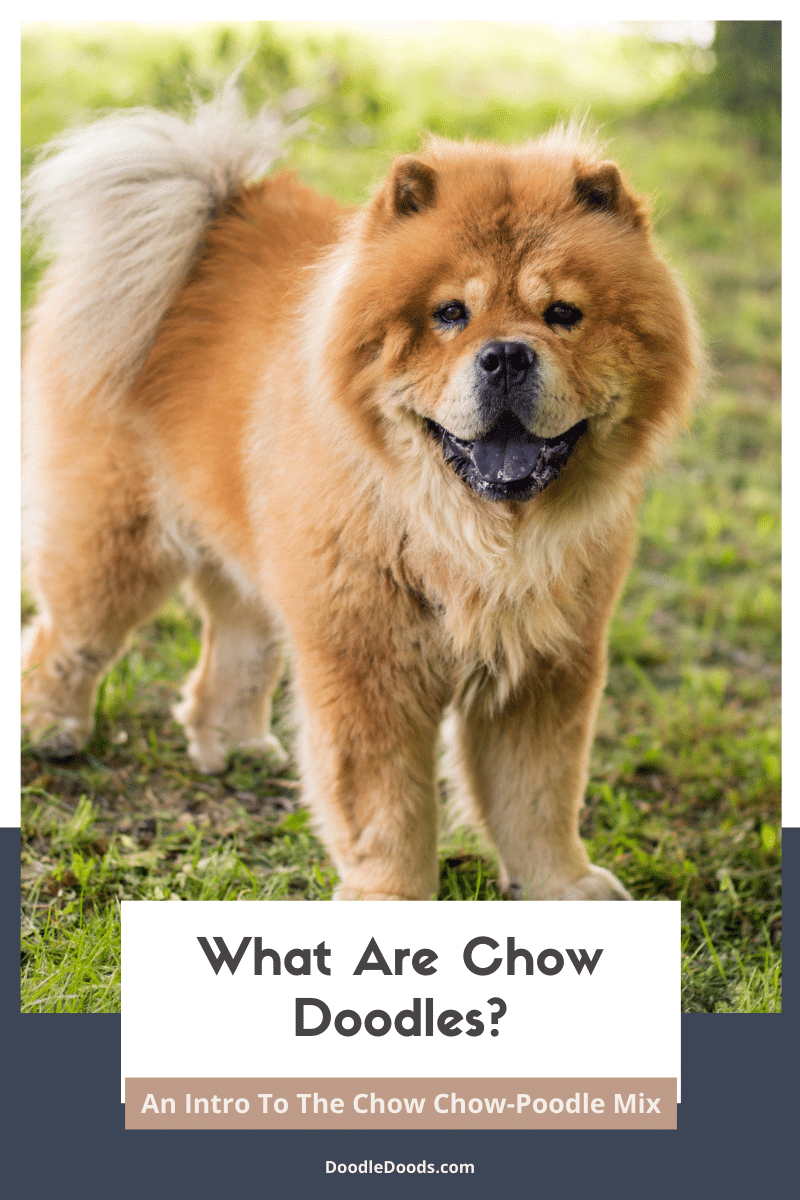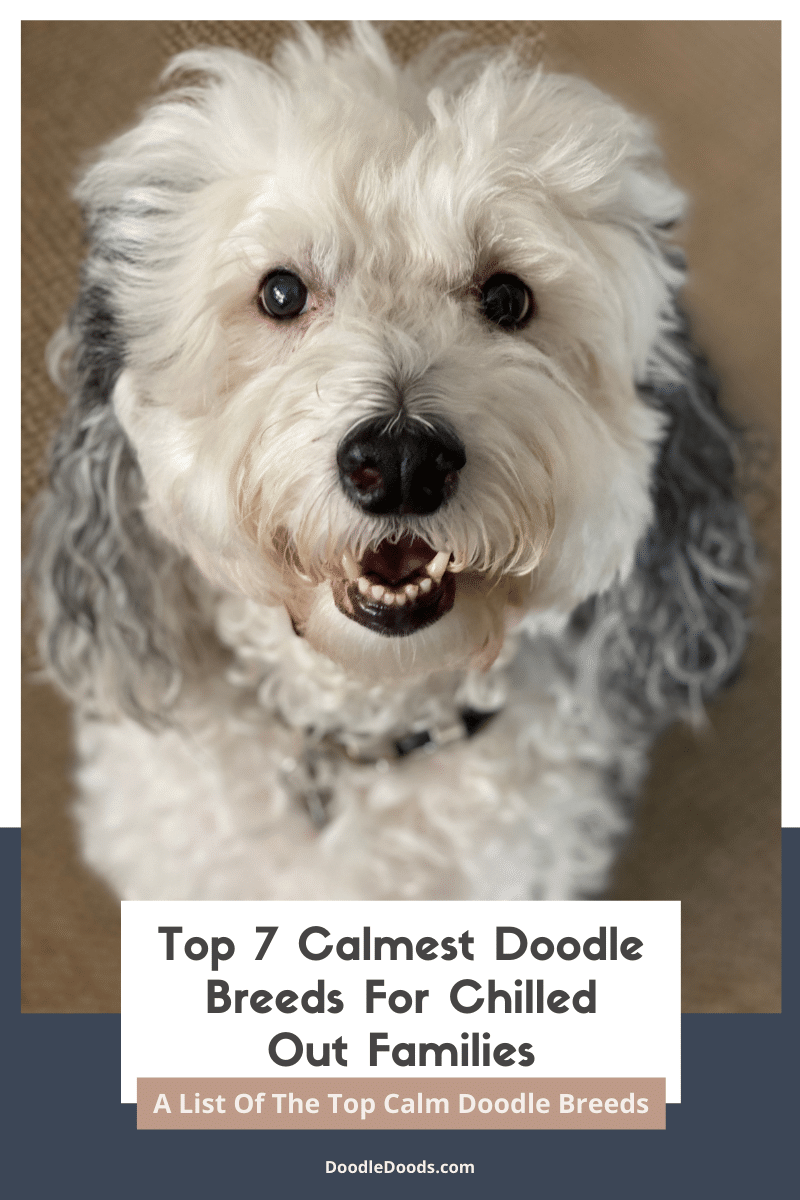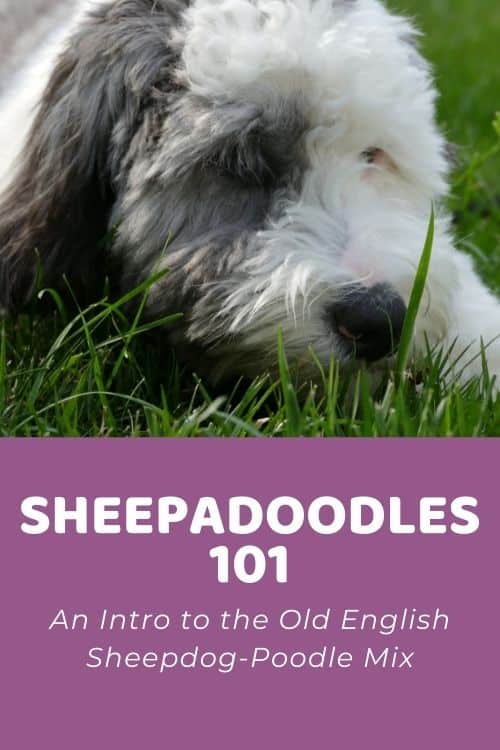The Golden Labradoodle might not be as well-known just yet, but we can guarantee that this hybrid cross is going to take the world by a storm in the next few years for sure. In this guide, we’re going to talk about the Golden Labradoodle – what they are, what’s their personality like, how big they get, and basically anything and everything you should know about the Golden Labradoodle. Let’s get into it!
Table of Contents
- Golden Labradoodle: Intro
- What Is A Golden Labradoodle?
- How Big Do Golden Labradoodles Get?
- Golden Labradoodle Temperament
- How Long Do Golden Labradoodles Live For?
- What Are The Common Health Issues Of A Golden Labradoodle?
- Golden Labradoodle Colors And Coat Type
- How To Groom A Golden Labradoodle?
- Should You Get A Golden Labradoodle?
- Golden Labradoodle: FAQs
- Golden Labradoodle: Final Thoughts
Golden Labradoodle: Intro
The mysterious, yet insanely adorable Golden Labradoodle is one of the newer and lesser known Poodle mixes. You probably know all too well about the OG Poodle mixes – Labradoodle and Goldendoodle. But what is a Golden Labradoodle and what makes this hybrid cross so special?
As we know by now, there are almost endless varieties of Poodle mixes and Doodles. There are some smaller Doods like the Cavapoo and Maltipoo, and then we’ve got those humongous pups like Bernedoodles and Saint Berdoodles.
But did you know that breeders are now also venturing into the wonderful world of combining two already established Doodle breeds? Of course, this makes those Doods even more interesting and exciting, so let’s talk about them!
What Is A Golden Labradoodle?
Don’t confuse the Golden Labradoodle with a gold-hued Labradoodle. Although they’re most definitely cute and amazing, that’s not the focus in today’s article. Instead, we’re going to talk about the Golden Labradoodle, also known as Goldendoodle-Labradoodle mix, or Golden Retriever-Labradoodle mix.
Technically, the Golden Labradoodle is a Double Doodle, meaning that they’re achieved by crossing a Goldendoodle to a Labradoodle. As both Goldendoodles and Labradoodles have been around the longest, the original Double Doodle was, in fact, a Golden Labradoodle. However, today there are a much wider variety of Double Doodles available, such as the Golden Mountain Doodle (Goldendoodle-Bernedoodle mix) and the Swiss Doodle (Aussiedoodle-Bernedoodle mix), to name a few.
To put it simply, a Golden Labradoodle is a triple hybrid cross between the Golden Retriever, Labrador Retriever, and Poodle. As you can already imagine, the Golden Labradoodle combines the best traits from all three of its purebred parents. They’re fun-loving, affectionate, outgoing, and intelligent Doods that make wonderful pets, therapy, and emotional support dogs.
And let’s not forget, the Golden Labradoodle is an excellent companion for people who either suffer from allergies or who just prefer a pup that doesn’t leave a trail of fur everywhere they go. As the Golden Labradoodle is usually created by crossing a Goldendoodle to a Labradoodle, their genetic makeup is generally at least 50% Poodle, meaning that they often inherit the Poodle’s low-shedding and allergy-friendly coat.
How Big Do Golden Labradoodles Get?
The Golden Labradoodle’s size is obviously inherited from their parents. As both Goldendoodles and Labradoodles come in a variety of sizes, the Golden Labradoodle can also come in either the smallest Toy Golden Labradoodle size and up to the largest Standard Golden Labradoodle.
Although both the purebred Golden Retriever and Labrador Retriever are rather large dogs, the former weighing about 55 to 75 pounds as an adult, and the latter weighing in at 55 to 80 pounds, adding the Poodle into the mix makes things a bit more complicated.
The Poodle comes in three different size categories – Standard, Miniature, and Toy Poodle. And by the way, both Labradoodles and Goldendoodles can be created with all sizes of the Poodle, resulting in different sized Doods.
As both the Goldendoodle and Labradoodle fall into very similar size categories, it’s that much easier for us to estimate the Golden Labradoodle sizes.
Here’s a helpful size chart for your reference:
| Toy Golden Labradoodle | Mini/Medium Golden Labradoodle | Standard Golden Labradoodle | |
| Weight | 10-25 pounds | 25-50 pounds | 50-90 pounds |
| Height* | Up to 15 inches | 15-20 inches | 20-26 inches |
| Ate At Full-Grown | 7.5-11 months | 11-13 months | 12.5-16 months |
*A dog’s height is measured from their withers, which is the highest part of their shoulder blades.
Therefore, Golden Labradoodles can weigh anywhere from 10 and up to 90 pounds, depending on the size of its parents and the Poodle used in the mix. For example, if we cross a Standard Goldendoodle with a Standard Labradoodle, the Golden Labradoodle puppies will also fall within the larger Standard Golden Labradoodle size category. Meanwhile, if we cross a smaller Mini Goldendoodle to a Mini Labradoodle, the Golden Labradoodle puppies will also be on the smaller side. You get the drift!
Nonetheless, as we’re combining two different Doodles together with three different purebreds in the mix, the outcome may surprise us. Especially if we’re talking about a Double Doodle that hasn’t been as established as their Goldendoodle and Labradoodle parents just yet.
Golden Labradoodle Temperament
When a Labradoodle is mixed with a Golden Retriever, we can expect the puppies to have quite similar temperament traits as their parents. We can expect Golden Labradoodles to be social, loving, playful, and just as fun to be around as their parents. They tend to get along very well with children, making them excellent pets for families with kids, too.
As all of the purebred parents in the mix are also highly intelligent, especially the insanely smart Poodle, the Golden Labradoodle also shines with its smarts and wits. They’re usually very easy to train and they’re eager to please their human parents, making this an absolute winning combination in a dog.
But nevertheless, if you’re planning on adopting a Golden Labradoodle, you’ve got to make sure to properly socialize and train your new puppy from a young age, as only this will let their personality and temperament shine. In addition to that, Golden Labradoodles also need plenty of mental and physical stimulation to prevent boredom and destructive behaviors. In fact, Golden Labradoodles are quite active dogs, which means that daily exercise is an absolute must for them.
Another thing to note with this Double Doodle is that they are often prone to separation anxiety. Due to their innate ability to form strong bonds with their families, they may struggle when having to spend long hours every day at home alone.
How Long Do Golden Labradoodles Live For?
The average Golden Labradoodle lifespan ranges between 12 and 15 years. And if you’re lucky and take good care of your pup, they might be around even longer than that! Additionally, smaller dogs tend to outlive larger ones, so it’s not uncommon for Toy and Mini Golden Labradoodles to have a longer life expectancy by a few years when compared to Standard Golden Labradoodles.
Another great thing about hybrid breeds like the Golden Labradoodle is that they also benefit from something called hybrid vigor. This means that hybrid breeds tend to live longer and healthier lives compared to their purebred parents, as they have a more diverse genetic makeup and breed-specific health conditions are less common than in their purebred parents.
What Are The Common Health Issues Of A Golden Labradoodle?
As we discussed, Golden Labradoodles are generally healthy dogs that live long and happy lives. But there’s a good reason for it too – ethical breeding practices. Responsible breeders extensively test their breeding dogs for numerous genetic conditions to ensure that their litters are born from healthy and strong bloodlines. Now, nature works in mysterious ways and there’s no way to guarantee that the Golden Labradoodle won’t ever inherit a genetic illness. Nonetheless, health screening and DNA testing is the best way to minimize the risks.
But even though Poodle mixes are typically healthy dogs, they’re still at risk of certain genetic illnesses that are common in Golden Retrievers, Labrador Retrievers, and Poodles. Some of the most common health issues in Golden Labradoodles include:
- Joint problems, including hip and elbow dysplasia, patellar luxation, and cruciate ligament damage;
- Eye diseases, such as progressive retinal atrophy (PRA) and cataracts;
- Skin allergies and food allergies;
- Skin problems, including sebaceous adenitis;
- Digestive issues and bloat;
- Ear infections due to the restricted airflow in their floppy ears;
- Hormonal issues, including hypothyroidism, hyperthyroidism, and Addison’s Disease;
- Certain heart conditions like subvalvular aortic stenosis.
Fortunately, many of their health issues can be prevented to some extent with a proper high-quality diet, daily exercise, and mental enrichment. And let’s not forget, all the affection you can give to your precious little (or not so little) Dood.
Golden Labradoodle Colors And Coat Type
Golden Labradoodle Colors
A fun thing about the Golden Retriever Labradoodle mix is that we never know what we might get! They inherit their coat colors from all sides of their lineage and there are almost endless possibilities with this triple hybrid cross.
Some of the most common colors in Golden Labradoodles include gold, apricot, red, chocolate, cream black, blue, tan, silver, champagne, silver beige, and white. But that’s not all! They can also come in various coat patterns, such as parti, tuxedo, sable, phantom, abstract, brindle, or the highly coveted merle.
Golden Labradoodle Coat Types: Are Golden Labradoodles Hypoallergenic?
Like with Labradoodles and Goldendoodles, one of the main appeals of Golden Labradoodles is that they’re usually low-shedding and allergy-friendly dogs. Some might even say hypoallergenic, but it’s a bit of a tricky topic.
Poodle mixes are generally considered suitable for people with allergies, as the Poodle’s genes tend to dominate. And if you know a little bit about Poodles, you know that their single-layered fur makes them ideal for allergic people.
Still, there’s actually no such thing as a 100% hypoallergenic dog, as all dogs excrete saliva, urine, and dog dander, which are the main culprits triggering allergies in humans. Of course, if a dog’s coat doesn’t shed much hair, all of those particles won’t end up all over your furniture, floors, and clothes, which can greatly minimize your allergic reactions.
The great thing about Golden Labradoodles is that they’re usually created by crossing a Goldendoodle with a Labradoodle. And as the low-shedding varieties are more sought-after, reputable breeders generally choose their breeding dogs very carefully, keeping in mind the parents’ coat types and shedding levels. In fact, many reputable breeders actually strive to breed low-shedding and allergy-friendly Double Doodles, and some of them even test their breeding dogs for coat genetics to ensure the safest option for their buyers.
Curly Coat
The curly coat is thick and dense, resembling the purebred Poodle. These pups generally come with single coats, which means that there’s no shedding undercoat. The downside of the curly coat is that it’s usually the hardest to maintain and manage, as the thick and textured curls easily trap in dirt, debris, and loose hair, leading to matted fur rather quickly.

Wavy Coat
The wavy coat isn’t curly or straight, but has more of a relaxed wave to it. The fur itself is usually soft and silky to touch, and it doesn’t get as easily tangled as the curly coat. On the other hand, wavy-coated Golden Labradoodles may come with an undercoat. So, if your wavy-coated Double Dood has an undercoat, you might notice a tiny bit of shedding from time to time.

Straight Coat
Lastly, there’s the straight coat, which more resembles purebred Golden Retrievers and Labrador Retrievers. The texture is more wiry and it typically comes with a shedding undercoat, making it the least allergy-friendly of the three. However, with regular brushing, you can minimize the shedding, as even straight-haired Golden Labradoodles usually shed much less than their purebred Retriever parents.
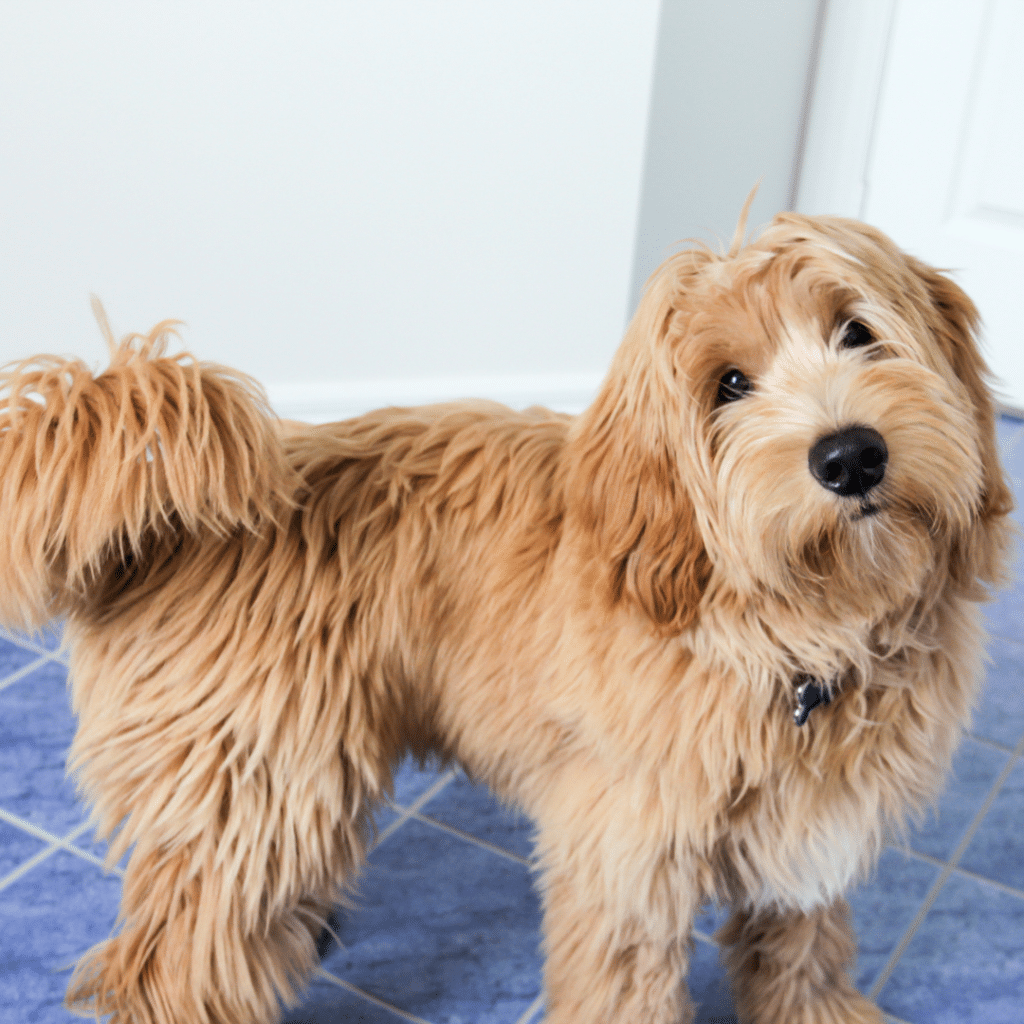
How To Groom A Golden Labradoodle?
Like with any other Doodle, Golden Labradoodles require quite a lot of upkeep to keep their coats and skin healthy and nourished. That’s mainly down to the fact that they’re prone to matting and their hair can grow quickly, which means that having a proper grooming routine is absolutely essential. Let’s now go over the most important steps in a Golden Labradoodle’s grooming routine:
Brushing
Brushing is probably the most important step in your Golden Labradoodle’s grooming routine. As all Poodle mixes are prone to matting, it’s vital that you regularly brush out any loose dog hair, dirt, debris, and the consequent knots and tangles to prevent matting. For this, make sure you get a good quality dog brush and a metal comb – slicker or pin brushes are generally best for Doodles.
But how often should you brush a Golden Labradoodle? We like to take things up a notch, so our recommendation is to brush your Dood daily. This is the single most effective thing you can do to prevent matted fur and promote good skin and coat health.
For curly-coated Golden Labradoodles, daily brushing is an absolute must. However, wavy coated Double Doodles may get away with a few less brushing sessions, about 3 to 4 times a week. For the straight-coated Goldendoodle-Labradoodle mix, daily brushing can also be very beneficial, as this will reduce loose dog hair and shedding.
A helpful tip: If you’re tired of brushing through all of that thick fur, then we recommend you get a dog detangler spray that’ll do half the job for you.
Bathing
Next up, don’t forget to regularly bathe your Golden Labradoodle pup, especially if they love to romp around outside. The frequency depends on your Doodle’s skin and coat conditions, activity levels, and lifestyle, but many owners prefer to bathe their Doodles about once a month or once every two months.
For bathing, make sure you choose a specially formulated dog shampoo, as human shampoos can trigger skin reactions and lead to a host of problems. We also recommend you check out our ultimate guide on how to bathe Doodles so that you can get your pup squeaky clean every time they step out of the shower.
Hair Trimming
As Golden Labradoodles grow their fur pretty much like humans do, they usually need haircuts about every 6 to 8 weeks. This is also a great time frame to give them a bath. You can either take your pup to a professional groomer for a nice trim, or instead learn how to do it at home with the help of our online course How To Groom A Doodle At Home.
When deciding on your Dood’s haircut, keep in mind that longer coats usually require more upkeep than shorter coats. As you can imagine, long fur tends to trap in more dirt and debris, and it can also become more easily tangled.
Other Grooming Activities
In addition to the grooming steps we mentioned above, you should also keep track of other activities like nail trimming, ear cleaning, and teeth brushing. PS! Don’t forget to gently, yet thoroughly dry your Golden Labradoodle’s ears after each swim and bathtime, as the moist environment is the perfect breeding ground for harmful bacteria.
Should You Get A Golden Labradoodle?
By now you’re either all set on adopting a Golden Labradoodle or you’re still trying to decide whether or not this pup is the right one for you. Let’s do a quick breakdown of everything we discussed in this guide so that you can make your decision knowing all the facts.
Pros Of Golden Labradoodles:
- They have wonderful temperaments, as they’re super friendly, outgoing, playful, and affectionate.
- They’re easy to train thanks to their high levels of intelligence.
- They get along well with people of all ages, including young children.
- They’re generally low-shedding and allergy-friendly.
- They come in multiple sizes, so you can adopt a pup according to your preference and living arrangement.
- Golden Labradoodles are generally healthy with a longer life expectancy when compared to purebred Retrievers.
Cons Of Golden Labradoodles:
- Not all Golden Labradoodles are hypoallergenic, so you must carefully choose one based on their coat type.
- They’re high-maintenance in terms of their grooming requirements.
- They’re prone to separation anxiety, which means that they’re not best suited for people who have to leave the house for long hours during the day.
- You have to be extremely careful about where you adopt your new puppy from, as you don’t want to unknowingly support puppy mills.
Golden Labradoodle: FAQs
Adopting a Golden Labradoodle puppy can set you back anywhere from $2,000 and up to $5,000 in the US. Although they’re quite pricey, please keep in mind that extensive work goes into ethically breeding Doodle puppies, and responsible breeding is something we feel very strongly about. So, if you can’t budget for a Golden Labradoodle puppy just yet, either keep your eyes peeled for puppies in rescues and shelters, or take some time to properly save up for your new best pal. Getting a healthy and happy puppy is more than worth the investment!
Neither of them is better than the other, as both Labradoodles and Goldendoodles are wonderful companions with many amazing traits. They’re both friendly and loving dogs with high levels of intelligence. They’re both also quite energetic and come in similar sizes. Additionally, they both have the same requirements when it comes to grooming, training, and exercise. However, based on our survey results, some people note that the Labradoodle can be a bit more laid back compared to the slightly more hyper Goldendoodle.
Golden Labradoodle: Final Thoughts
We hope this in-depth guide about the Goldendoodle-Labradoodle mix has shed some light onto this wonderful Double Doodle. If you’re looking for a pup that will love you unconditionally and bring joy to your life, then it’s definitely worth considering getting a Golden Labradoodle! They’re smart, loving companions who come in all shapes and sizes. Just make sure to research the breeder carefully before committing so that you can be sure your puppy is coming from an ethical source. And don’t forget about their grooming needs – it may take some effort, but it’ll be well worth the reward of having a happy and healthy pup by your side!
Want to Learn
DIY Doodle Grooming?
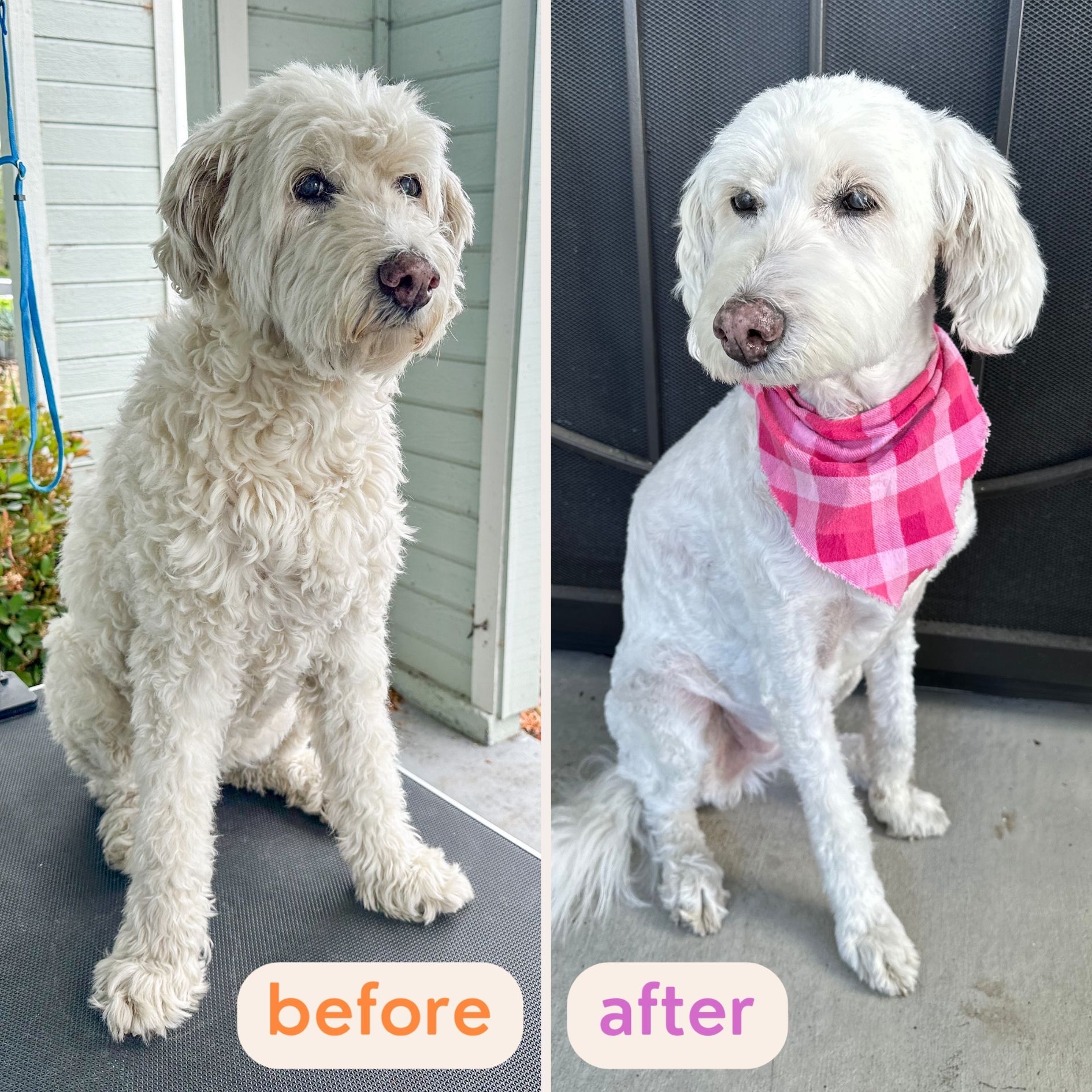
 “Every concern and question I had now has clear, practical solutions.” – Paula D.
“Every concern and question I had now has clear, practical solutions.” – Paula D.
 “These lessons have provided tremendous amounts of information.” – Steve B.
“These lessons have provided tremendous amounts of information.” – Steve B.
 “Buy the course and complain about how easy it is!” – Chris S.
“Buy the course and complain about how easy it is!” – Chris S.
Learn How To Groom Your Doodle At Home…
Safely…And Without Confusion:







